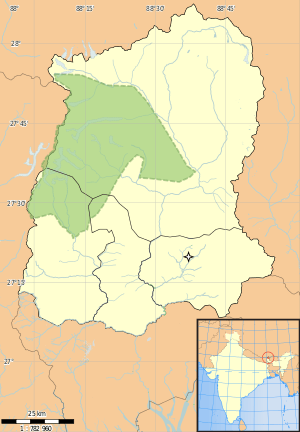Chungthang
| Chungthang चुंगतांग | |
|---|---|
| town | |
|
View of Chungthang, 1938 | |
 Chungthang  Chungthang Location in Sikkim, India | |
| Coordinates: 27°36′16″N 88°38′44″E / 27.6045°N 88.645583°ECoordinates: 27°36′16″N 88°38′44″E / 27.6045°N 88.645583°E | |
| Country |
|
| State | Sikkim |
| District | North Sikkim |
| Elevation | 1,790 m (5,870 ft) |
| Languages | |
| • Official | Nepali, Bhutia, Lepcha |
| Time zone | IST (UTC+5:30) |
| Vehicle registration | SK |
Chungthang is a town in North Sikkim district in the Indian state of Sikkim. It is situated at the confluence of the Lachen and Lachung rivers, which combine to form the Teesta River.[1] Located at a distance of 95 kilometres (59 mi) from the state capital Gangtok, the Indian Army has a major forward base with a medical centre in Chungthang.
Geography
Chungthang is located at 27°37′N 88°38′E / 27.62°N 88.63°E.[2] It has an average elevation of 1,790 metres (5,870 ft).
History
According to the Denjong Nye-Yig( The pilgrim's Guide to the Hidden Land of Sikkim , by Jigmee pawo, erincarnation of gyalwa Lhatsun Chempo) and Nay-Sol texts, Chungthang is derived from the lepcha language as top precious plains, the Buddhist Guru Padmasambhava during 7th Century visited the town before going to Tibet and left his footprint on a rock where he once rested.This rock is revered by busshists for its sacred rock known as "Nyedo" blessed by Guru Padmasambhava. Around the rock some paddy rice grows, which is supposed to be a miracle as paddy does not grow in these conditions.Guru padmasmabhava dug in his walking stick at a place where eventually it grew into a tree, which had a stick-shaped trunk and leaves below the rounded trunk that look like the handle of a stick. An (holy water tank) was also made to appear here by the Guru. Guru Padmasambhava visited the place during 7th century in order to give solace the Karma Pa Nying Ma Pa sect then being hounded out from Tibet by the Ge Lug Pa sect. It is also said that Guru Padmasambhava, on one of his journeys , had come across this place and vanquished demons here before proceeding.
Thus the name Tshungthang was beston on the place from that moment then .
People
Most of the residents of the town are Lepcha and they follows Buddhist religion and Christianity.[1] Chungthang is rich in biodiversity with a wide variety of orchids, plants and animals. As of the 2001 Census of India, the village had a population of 3,766 with a population density of approximately three persons per hectare.[3]
References
- 1 2 "North Skikkim". National Informatics Centre. Retrieved 12 August 2015.
- ↑ Falling Rain Genomics, Inc - Chungthang
- ↑ Choudhury, Maitreyee (2006). Sikkim: Geographical Perspectives. Mittal Publications. p. 109. ISBN 978-81-8324-158-8.
